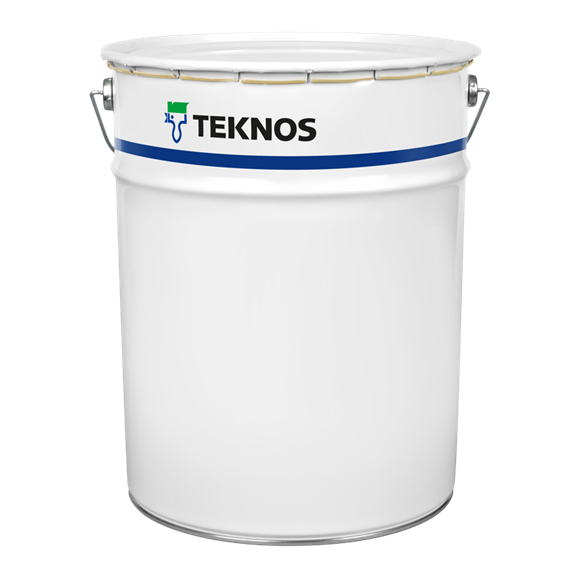TEKNOCRYL AQUA PRIMER 2788-72
Acrylate primer

- Corrosion protective
- 1-component
- Water-borne
- DTM (direct-to-metal)
- Primer
TEKNOCRYL AQUA PRIMER 2788-72 is a fast drying, one-pack water-based universal primer that contains active anti-corrosive pigments.
Due to the adhesive properties and overcoatability it is suitable for steel, zinc and aluminium surfaces as an universal primer or as an one-coat paint and also for us in painting systems in corrosivity classes C2 and C3 as a shop primer. TEKNOCRYL AQUA PRIMER 2788-72 can be overcoated with many one- and two-pack paints such as water-borne acrylate, epoxy and polyurethane paints and also with solvent-borne polyurethane and xylene-based alkyd paints.
Technical data sheet
Surface preparation
Remove from the surfaces any contaminants that might be detrimental to surface preparation and application. Remove also water-soluble salts by using appropriate methods. The surfaces are prepared according to the different materials as follows:
STEEL SURFACES: Remove mill scale and rust by blast cleaning to preparation grade Sa 2½ (standard ISO 8501-1). Roughening the surface of thin-plate improves the adhesion of the paint to the substrate.
ZINC SURFACES: Hot-dip-galvanized steel structures that are exposed to atmospheric corrosion can be painted if the surfaces are sweep blast-cleaned (SaS) till matt all over. Suitable cleaning agents are, e.g. aluminium oxide and natural sand. It is not recommended according to standard ISO 12944-5 to paint hot-dip-galvanized objects that are subjected to immersion strain. Painting of hot-dip-galvanized objects that are subjected to immersion strain must be discussed separately with Teknos. It is recommended that new zinc-coated thin-plate structures are treated with sweep blast-cleaning (SaS). Thin-plate surfaces that have been weathered to matt can be treated also with RENSA STEEL washing agent.
ALUMINIUM SURFACES: Treat the surfaces with RENSA STEEL washing agent. Surfaces that are exposed to weathering are also roughened up with sweep blast-cleaning (AlSaS) or sanding.
OLD PAINTED SURFACES SUITABLE FOR OVERCOATING: Any impurities that might be detrimental to the application of paint (e.g. grease and salts) are removed. The surfaces must be dry and clean. Old, painted surfaces that have exceeded the maximum overcoating time are to be roughened as well. Damaged parts are prepared in accordance with the requirements of the substrate and the maintenance coating.
The place and time of the preparation are to be chosen so that the prepared surface will not get dirty or damp before the subsequent treatment.
Additional instructive information for surface preparation can be found in standards EN ISO 12944-4 and ISO 8501-2.
Application
Stir thoroughly before use.
Apply preferably by airless spray as only this method provides the recommended film thickness in a single operation. Suitable airless nozzle size 0.013 - 0.018". Spray evenly to the specified film thickness. Special care should be taken when spraying edges, corners and welding joints. Small areas can also be painted with a brush, but in this case one additional coat has to be applied in order to achieve the specified film thickness.
Application conditions
The surface to be treated must be dry. During the application and drying period the temperature of the ambient air, the surface and the product shall be above +15°C and the relative air humidity below 70%. Additionally, the temperature of the surface to be treated and the product must be at least +3°C above the dew point of the ambient air. Especially when applying with a spray the relative air humidity should be above 30% to avoid the onset of the drying process to be too fast.
Surface temperature, film thickness, drying temperature and ventilation affect the drying of the paint. The paint is dry when all water has evaporated from the paint film. It is essential that all painted surfaces have sufficient ventilation. If the painted surface will be exposed to weathering, moisture or low temperatures (below +10°C) thick paint films are to be avoided and the last coat must be allowed to dry for at least 40 hours (at +23°C) before exposure. Low temperatures and insufficient ventilation slow down the drying process.
Storage
The storage stability is shown on the label. Must be stored tightly closed and kept cool. Do not transport or store at temperatures below 0°C.
Must not freeze.
| Total mass of solids | abt. 650 g/l |
|---|---|
| Volatile organic compound (VOC) | abt. 32 g/l |
| Gloss | Matt |
| Practical spreading rate | The values depend on the application technique, surface conditions, overspray, etc. |
| Drying time – dust free | 20 min (ISO 9117-3:2010) |
| Drying time – touch dry | 20 min (ISO 9117-5:2012) |
| Thinner | Water. |
| Clean up | Water. When painting equipment used for application of solvent-borne paints is used for water-borne paints the equipment must be cleaned carefully: 1. Wash with solvent. 2. Wash with washing solvent for water-borne paints, e.g. TEKNOSOLV 6060. 3. Rinse with water. When shifting from water-borne to solvent-borne paints act in reverse order. |
| Colours | Black, RAL-7021 and RAL-7045. |
| Safety markings | See safety data sheet. |